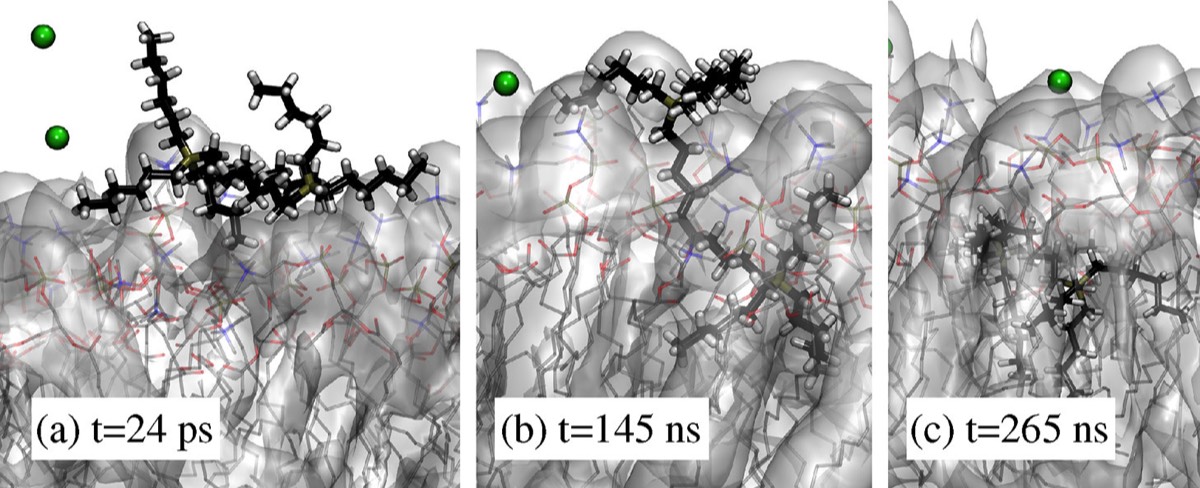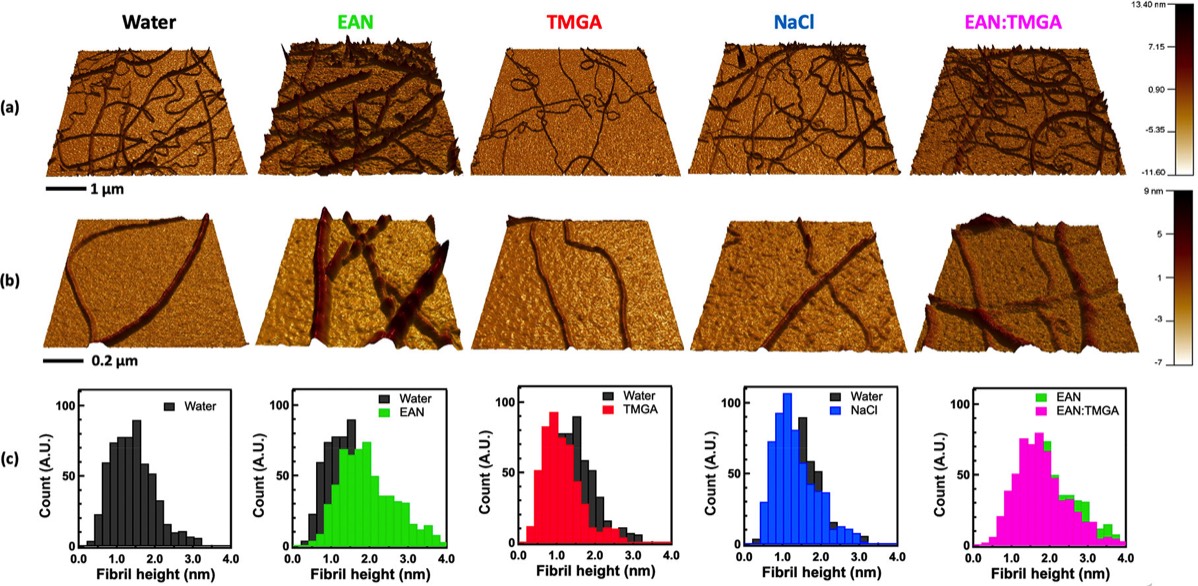Ionic liquids, biomolecules and cells
Ionic liquids (ILs) are a vast and relatively new class of organic electrolytes composed by an organic cation and either an organic or inorganic anion, which posses a series of intriguing properties as having low vapour pressure and being liquid around room temperature (Fig. 1). Several studies have shown that ILs can be toxic to cells, microorganism, plants and, potentially, humans. Toxicity, however, is synonym of affinity and this has motivated a series of investigations looking towards applications in pharmacology, bio-nanomedicine and, more in general, bio-nanotechnology. The knowledge of the chemical-physical interactions and mechanisms in IL-biomolecule systems represent a necessary step to exploit their potential use in high-impact applications. Our main interest in this area lies in the study of IL-biomembrane interactions. In this context, we have pioneered the first experimental investigation of the partitioning of ILs in model biomembranes made by phospholipid bilayers solvated in aqueous solutions (Fig. 2) and, more recently, looked with MD simulations at the absorption of phosphonium-based ILs - ILs with a marked antibacterial character - in lipid bilayers (Fig. 3). We were also the first team to focus on the effect of subtoxic doses of ILs on cell membrane viscoelasticity and cell mobility (Fig. 4). Another major research interest we have in this area is on the interaction of ILs with proteins and fibril amyloids. In this context, we were the first team looking at the opposite effect of ionic liquids on protein amyloidogenesys at microscopic level (Fig. 5). Other research interests in this field include the interaction between ILs with DNA, cells and tissue (Fig. 6). Neutron scattering, atomic force microscopy and computer simulations are the three major techniques used for these studies, which are combined with a series of complementary approaches including static and dynamic light scattering, calorimetry, fluorescence and electron microscopies, Raman and infrared spectroscopies, and a palette of many biological assays.

Fig. 1 - Structural formula of cations and anions of selected ILs. The magnetic ILs (MILs) subcategory consists of magnetic ionic liquid anions. The amino acid ILs (AAILs) consist of anions made of deprotonated amino acids; they can also exist as cations. Taken from our Langmuir 2018

Fig. 2 - Supported phospholipid bilayers doped with ionic liquids. (a-c) Density distribution profiles as a function of height z from the surface of the substrate obtained by fitting the neutron reflectivity data. Neutron reflectometry has allowed to model each single supported phospholipid bilayers with four different density distributions accounting for: (i) the inner lipid heads (cyan), (ii) the inner lipid tail (blue), (iii) the outer lipid tail (blue), (iv) the outer lipid heads (cyan); and also (v) the density distribution of the cations (red), whereas the anion (Cl) is almost invisible to neutrons. Three cases are here reported where two different phospholipid bilayers interact with aqueous solutions of two different ILs at 0.5 M: (a) POPC and [Chol][Cl], (b) POPC and [C4mim][Cl], and (c) DMPC and [C4mim][Cl]. IL cations absorption accounts for 8%, 6.5%, and 11% of the lipid bilayer volume respectively. In (c), the diffusion of the cations into the inner leaflet is apparent, and this can imply diffusion into the cytoplasm through the cellular lipid membrane. In (d), a representative molecular dynamics simulations configuration of the [C4mim] IL-cation in close contact with a POPC molecule. Adapted from our J Phys Chem B 2014 and J Chem Phys 2015

Fig. 3 - Sequence of snapshots from our MD simulations of virtually independent phosphonium di-cations [DxC10]2+ and [Cl]− anions in solution, illustrating the successive stages of one [DxC10]2+ entering the lipid layer. (a) The dication is adsorbed at the water/lipid interface, (b) one of the cationic heads entered the lipid phase, and (c) the whole dication is absorbed in the lipid phase. The dication structure is identified by the thick bond lines. Time is measured from the unrelaxed insertion of the ions in the water interlayer in close contact with the lipid bilayer. Taken from our J Phys Chem B 2022

Fig. 4 - Cell migration and cellular lipid membrane elasticity for MDA-MB-231 cells incubated at subtoxic concentrations of imidazolium-ILs showing a correlation relationship between the ability of ILs to reduce the cell membrane elasticity and their ability to enhance cell migration. Taken from our J Phys Chem Lett 2020

Fig. 5 - Representative height 3D atomic force microscopy (AFM) images (a), zoom images (b), and histogram distributions (c) of lysozyme amyloid fibrils incubated in sole water (black) and water solutions of ethyl ammonium nitrate (EAN) in green, tetramethylguanidinium acetate (TMGA) in red, and sodium chloride (NaCl) in blue at a molar ratio of 3.5 ILs per protein. The last column reports the results upon incubation in a water solution of a mix of the two ILs at a relative lysozyme:EAN:TMGA molar concentration of 1:1:3.5 (pink). The distributions in panel (c) are not limited to the data in panel (a) but have been obtained using many sets of AFM data. Taken from our J Phys Chem Lett 2022

Fig. 6 - Sketch summarizing the main mechanisms of action (MoAs) of ILs towards living cells. The red star stays for ILs. ILs interact with cells in a variety of different mechanisms including: alteration of lipid distribution and cell membrane viscoelasticity, disruption of cell and nuclear membranes, mitochondrial permeabilization and dysfunction, generation of reactive oxygen species, chloroplast damage (in plants), alteration of transmembrane and cytoplasmatic proteins/enzyme functions, alteration of signaling pathways, and DNA fragmentation. The knowledge of the MoAs of ILs is a key step in the development of applications in pharmacology, nano-bio medicine and bio-nanotechnology. Taken from our Biophys Rev 2020
Selected publications:
Ionic liquids meet lipid bilayers: a state-of-the-art review
A. Benedetto, Biophysical Reviews, 15, 1909, (2023)
>>>> LINK TO THE PAPER <<<<
A. Benedetto, Biophysical Reviews, 15, 1909, (2023)
>>>> LINK TO THE PAPER <<<<
Controlling Amyloid Fibril Properties Via Ionic Liquids: The Representative Case of Ethylammonium Nitrate and Tetramethylguanidinium Acetate on the Amyloidogenesis of Lysozyme
V. Pillai, P. Kumari, S. Kolagatla, V.G. Sakai, S. Rudić, B. Rodriguez, M. Rubini, K. Tych, A. Benedetto, Journal of Physical Chemistry Letters, 13, 7058, (2022)
>>>> LINK TO THE PAPER <<<<
>>>> Featuring on the JOURNAL COVER <<<<
V. Pillai, P. Kumari, S. Kolagatla, V.G. Sakai, S. Rudić, B. Rodriguez, M. Rubini, K. Tych, A. Benedetto, Journal of Physical Chemistry Letters, 13, 7058, (2022)
>>>> LINK TO THE PAPER <<<<
>>>> Featuring on the JOURNAL COVER <<<<
Absorption of the [bmim][Cl] Ionic Liquid in DMPC Lipid Bilayers Across Their Gel, Ripple, and Fluid Phases
A. Benedetto, E. Kelley, Journal of Physical Chemistry B, 126, 3309, (2022)
>>>> LINK TO THE PAPER <<<<
>>>> Featuring on the JOURNAL COVER <<<<
A. Benedetto, E. Kelley, Journal of Physical Chemistry B, 126, 3309, (2022)
>>>> LINK TO THE PAPER <<<<
>>>> Featuring on the JOURNAL COVER <<<<
Absorption of Phosphonium Cations and Dications into a Hydrated POPC Phospholipid Bilayer: A Computational Study
V. Pillai, P. Kumari, A. Benedetto, D. Gobbo, P. Ballone, Journal of Physical Chemistry B, 126, 4272, (2022)
>>>> LINK TO THE PAPER <<<<
>>>> Featuring on the JOURNAL COVER <<<<
V. Pillai, P. Kumari, A. Benedetto, D. Gobbo, P. Ballone, Journal of Physical Chemistry B, 126, 4272, (2022)
>>>> LINK TO THE PAPER <<<<
>>>> Featuring on the JOURNAL COVER <<<<
Stiffening Effect of the [Bmim][Cl] Ionic Liquid on the Bending Dynamics of DMPC Lipid Vesicles
P. Kumari, A. Faraone, E. Kelley, A. Benedetto, Journal of Physical Chemistry B, 125, 7241, (2021)
>>>> LINK TO THE PAPER <<<<
>>>> Featuring on the JOURNAL COVER <<<<
P. Kumari, A. Faraone, E. Kelley, A. Benedetto, Journal of Physical Chemistry B, 125, 7241, (2021)
>>>> LINK TO THE PAPER <<<<
>>>> Featuring on the JOURNAL COVER <<<<
The transition from salt-in-water to water-in-salt nanostructures in water solutions of organic ionic liquids relevant for biological applications
P. Kumari, V. Pillai, D. Gobbo, P. Ballone, A. Benedetto, Physical Chemistry Chemical Physics, 23, 944, (2021)
>>>> LINK TO THE PAPER <<<<
P. Kumari, V. Pillai, D. Gobbo, P. Ballone, A. Benedetto, Physical Chemistry Chemical Physics, 23, 944, (2021)
>>>> LINK TO THE PAPER <<<<
Computational analysis of the effect of [Tea][Ms] and [Tea][H2PO4] ionic liquids on the structure and stability of Aβ(17–42) amyloid fibrils
D. Gobbo, A. Cavalli, P. Ballone, A. Benedetto, Physical Chemistry Chemical Physics, 23, 6695, (2021)
>>>> LINK TO THE PAPER <<<<
D. Gobbo, A. Cavalli, P. Ballone, A. Benedetto, Physical Chemistry Chemical Physics, 23, 6695, (2021)
>>>> LINK TO THE PAPER <<<<
Sub-Toxic Concentrations of Ionic Liquids Enhance Cell Migration by Reducing the Elasticity of the Cellular Lipid Membrane
P. Kumari, V. Pillai, B.J. Rodriguez, M. Prencipe, A. Benedetto, Journal of Physical Chemistry Letters, 11, 7372, (2020)
>>>> LINK TO THE PAPER <<<<
P. Kumari, V. Pillai, B.J. Rodriguez, M. Prencipe, A. Benedetto, Journal of Physical Chemistry Letters, 11, 7372, (2020)
>>>> LINK TO THE PAPER <<<<
Mechanisms of action of ionic liquids on living cells: the state of the art
P. Kumari, V. Pillai, A. Benedetto, Biophysical reviews, 12, 1187, (2020)
>>>> LINK TO THE PAPER <<<<
P. Kumari, V. Pillai, A. Benedetto, Biophysical reviews, 12, 1187, (2020)
>>>> LINK TO THE PAPER <<<<
Room-Temperature Ionic Liquids and Bio-Membranes: Setting the Stage for Applications in Pharmacology, Bio-Medicine and Bio-Nano-Technology
A Benedetto and P. Ballone, Langmuir, 34, 9579, (2018)
>>>> LINK TO THE PAPER <<<<
A Benedetto and P. Ballone, Langmuir, 34, 9579, (2018)
>>>> LINK TO THE PAPER <<<<
Ionic Liquids in Protein Amyloidogenesis: A Brief Screenshot of the State-of-the-Art
V Pillai, A. Benedetto, Biophysical reviews, 10, 847, (2018)
>>>> LINK TO THE PAPER <<<<
V Pillai, A. Benedetto, Biophysical reviews, 10, 847, (2018)
>>>> LINK TO THE PAPER <<<<
Controlling the Mechanoelasticity of Model Biomembranes with Room-Temperature Ionic Liquids
C. Rotella, P. Kumari, B.J. Rodriguez, S.P. Jarvis, A. Benedetto, Biophysical reviews, 10, 751, (2018)
>>>> LINK TO THE PAPER <<<<
C. Rotella, P. Kumari, B.J. Rodriguez, S.P. Jarvis, A. Benedetto, Biophysical reviews, 10, 751, (2018)
>>>> LINK TO THE PAPER <<<<
Room-Temperature Ionic Liquids Meet Bio-Membranes: The State-of-the-Art
A. Benedetto, Biophysical reviews, 9, 309, (2017)
>>>> LINK TO THE PAPER <<<<
A. Benedetto, Biophysical reviews, 9, 309, (2017)
>>>> LINK TO THE PAPER <<<<
Room Temperature Ionic Liquids Meet Bio-Molecules: a Microscopic View of Structure and Dynamics
A. Benedetto and P. Ballone, ACS Sustainable Chemistry & Engineering, 4, 392, (2016)
>>>> LINK TO THE PAPER <<<<
A. Benedetto and P. Ballone, ACS Sustainable Chemistry & Engineering, 4, 392, (2016)
>>>> LINK TO THE PAPER <<<<
Room-Temperature Ionic Liquids Interacting with Biomolecules: An Overview of Experimental and Computational Studies
A. Benedetto and P. Ballone, Philosophical Magazine, 96, 860, (2016)
>>>> LINK TO THE PAPER <<<<
A. Benedetto and P. Ballone, Philosophical Magazine, 96, 860, (2016)
>>>> LINK TO THE PAPER <<<<
Structure and Dynamics of POPC Bilayers in Water Solutions of Room-Temperature Ionic Liquids
A. Benedetto. R.J. Bingham, P. Ballone, Journal of Chemical Physics, 142, 124706, (2015)
>>>> LINK TO THE PAPER <<<<
A. Benedetto. R.J. Bingham, P. Ballone, Journal of Chemical Physics, 142, 124706, (2015)
>>>> LINK TO THE PAPER <<<<
Structure and Stability of Phospholipid Bilayers Hydrated by a Room-Temperature Ionic Liquid/Water Solution: A Neutron Reflectivity Study
A. Benedetto, F. Heinrich, M. Gonzalez, G. Fragneto, E. Watkins, P. Ballone, Journal of Physical Chemistry B, 118, 12192, (2014)
>>>> LINK TO THE PAPER <<<<
A. Benedetto, F. Heinrich, M. Gonzalez, G. Fragneto, E. Watkins, P. Ballone, Journal of Physical Chemistry B, 118, 12192, (2014)
>>>> LINK TO THE PAPER <<<<
Amino Acid Anions in Organic Ionic Compounds. An ab Initio Study of Selected Ion Pairs
A. Benedetto, E. Bodo, L. Gontrani, P. Ballone, R. Caminiti, Journal of Physical Chemistry B, 118, 2471, (2014)
>>>> LINK TO THE PAPER <<<<
A. Benedetto, E. Bodo, L. Gontrani, P. Ballone, R. Caminiti, Journal of Physical Chemistry B, 118, 2471, (2014)
>>>> LINK TO THE PAPER <<<<